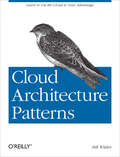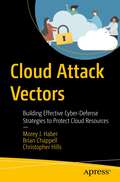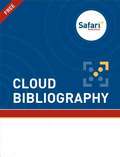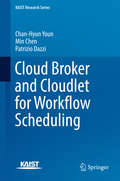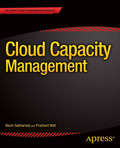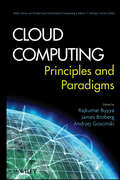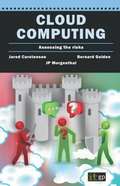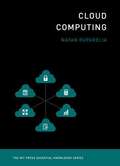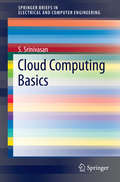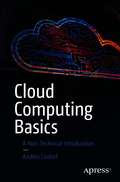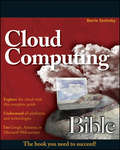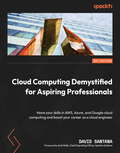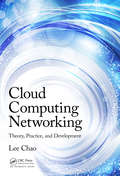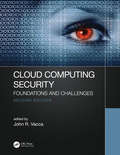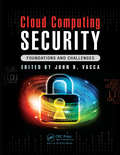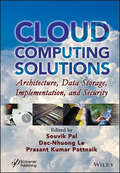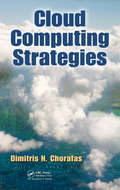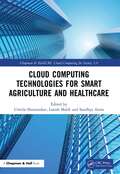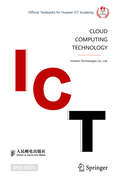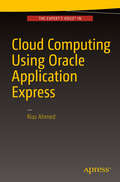- Table View
- List View
Cloud Architecture Patterns: Using Microsoft Azure
by Bill WilderIf your team is investigating ways to design applications for the cloud, this concise book introduces 11 architecture patterns that can help you take advantage of cloud-platform services. You’ll learn how each of these platform-agnostic patterns work, when they might be useful in the cloud, and what impact they’ll have on your application architecture. You’ll also see an example of each pattern applied to an application built with Windows Azure.The patterns are organized into four major topics, such as scalability and handling failure, and primer chapters provide background on each topic. With the information in this book, you’ll be able to make informed decisions for designing effective cloud-native applications that maximize the value of cloud services, while also paying attention to user experience and operational efficiency.Learn about architectural patterns for:Scalability. Discover the advantages of horizontal scaling. Patterns covered include Horizontally Scaling Compute, Queue-Centric Workflow, and Auto-Scaling.Big data. Learn how to handle large amounts of data across a distributed system. Eventual consistency is explained, along with the MapReduce and Database Sharding patterns.Handling failure. Understand how multitenant cloud services and commodity hardware influence your applications. Patterns covered include Busy Signal and Node Failure.Distributed users. Learn how to overcome delays due to network latency when building applications for a geographically distributed user base. Patterns covered include Colocation, Valet Key, CDN, and Multi-Site Deployment.
Cloud Attack Vectors: Building Effective Cyber-Defense Strategies to Protect Cloud Resources
by Morey J. Haber Brian Chappell Christopher HillsCyberattacks continue to increase in volume and sophistication, targeting everything owned, managed, and serviced from the cloud. Today, there is widespread consensus—it is not a matter of if, but rather when an organization will be breached. Threat actors typically target the path of least resistance. With the accelerating adoption of cloud technologies and remote work, the path of least resistance is shifting in substantive ways. In recent years, attackers have realigned their efforts, focusing on remaining undetected, monetization after exploitation, and publicly shaming organizations after a breach.New, innovative, and useful products continue to emerge and offer some cloud protection, but they also have distinct limitations. No single, standalone solution or strategy can effectively protect against all cloud attack vectors or identify all malicious activity. The simple fact is that the cloud is based on a company’s assets being offered as services. As a result, the best security any organization can achieve is to establish controls and procedures in conjunction with services that are licensed in the cloud.Cloud Attack Vectors details the risks associated with cloud deployments, the techniques threat actors leverage, the empirically-tested defensive measures organizations should adopt, and shows how to improve detection of malicious activity.What You’ll Learn Know the key definitions pertaining to cloud technologies, threats, and cybersecurity solutionsUnderstand how entitlements, permissions, rights, identities, accounts, credentials, and exploits can be leveraged to breach a cloud environmentImplement defensive and monitoring strategies to mitigate cloud threats, including those unique to cloud and hybrid cloud environmentsDevelop a comprehensive model for documenting risk, compliance, and reporting based on your cloud implementation Who This Book Is ForNew security professionals, entry-level cloud security engineers, managers embarking on digital transformation, and auditors looking to understand security and compliance risks associated with the cloud
Cloud Auditing Best Practices: Perform Security and IT Audits across AWS, Azure, and GCP by building effective cloud auditing plans
by Shinesa Cambric Michael RatemoEnsure compliance across the top cloud players by diving into AWS, Azure, and GCP cloud auditing to minimize security risksKey FeaturesLeverage best practices and emerging technologies to effectively audit a cloud environmentGet better at auditing and unlock career opportunities in cloud audits and complianceExplore multiple assessments of various features in a cloud environment to see how it's doneBook DescriptionAs more and more companies are moving to cloud and multi-cloud environments, being able to assess the compliance of these environments properly is becoming more important. But in this fast-moving domain, getting the most up-to-date information is a challenge—so where do you turn? Cloud Auditing Best Practices has all the information you'll need. With an explanation of the fundamental concepts and hands-on walk-throughs of the three big cloud players, this book will get you up to speed with cloud auditing before you know it. After a quick introduction to cloud architecture and an understanding of the importance of performing cloud control assessments, you'll quickly get to grips with navigating AWS, Azure, and GCP cloud environments. As you explore the vital role an IT auditor plays in any company's network, you'll learn how to successfully build cloud IT auditing programs, including using standard tools such as Terraform, Azure Automation, AWS Policy Sentry, and many more. You'll also get plenty of tips and tricks for preparing an effective and advanced audit and understanding how to monitor and assess cloud environments using standard tools. By the end of this book, you will be able to confidently apply and assess security controls for AWS, Azure, and GCP, allowing you to independently and effectively confirm compliance in the cloud.What you will learnUnderstand the cloud shared responsibility and role of an IT auditorExplore change management and integrate it with DevSecOps processesUnderstand the value of performing cloud control assessmentsLearn tips and tricks to perform an advanced and effective auditing programEnhance visibility by monitoring and assessing cloud environmentsExamine IAM, network, infrastructure, and logging controlsUse policy and compliance automation with tools such as TerraformWho this book is forThis book is for IT auditors looking to learn more about assessing cloud environments for compliance, as well as those looking for practical tips on how to audit them and what security controls are available to map to IT general computing controls. Other IT professionals whose job includes assessing compliance, such as DevSecOps teams, identity, and access management analysts, cloud engineers, and cloud security architects, will also find plenty of useful information in this book. Before you get started, you'll need a basic understanding of IT systems and a solid grasp of cybersecurity basics.
Cloud Based 5G Wireless Networks (SpringerBriefs in Computer Science)
by Min Chen Yin ZhangThis SpringerBrief introduces key techniques for 5G wireless networks. The authors cover the development of wireless networks that led to 5G, and how 5G mobile communication technology (5G) can no longer be defined by a single business model or a typical technical characteristic. The discussed networks functions and services include Network Foundation Virtualization (N-FV), Cloud Radio Access Networks (Cloud-RAN), and Mobile Cloud Networking (MCN). The benefits of cloud platforms are examined, as are definable networking and green wireless networking. Other related and representative projects on 5G are mobile and wireless communications enablers for the Twenty-Twenty Information Society, Multi-hop Cellular Networks, Network Function as-a-Service over Virtualized Infrastructures, iJOIN, and Nuage Virtualized Services Platform. Major applications of 5G range from RAN sharing and Multi-Operator Core Networks to mobile convergence. Enhancing the user experience by providing smart and customized services, 5G will support the explosive growth of big data, mobile internet, digital media, and system efficiency. This SpringerBrief is designed for professionals, researchers, and academics working in networks or system applications. Advanced-level students of computer science or computer engineering will also find the content valuable.
Cloud Bibliography
by Safari Content TeamOne of the greatest changes in the computing world has been the move to using common, distributed hardware and software to support services, coined cloud computing. We have chosen a selection of the most useful books in cloud computing within this bibliography. First we look at the basics and some of the key concepts and issues that arise in Cloud computing in general. Then we examine how the 'as a service' (aaS) has helped to drive and expand the reach of the cloud deployment environment. Next, the role of different cloud services, both internal to support cloud operations, and externally provided as a part of the web of cloud operational support are covered. Virtualization, the effective division of computing to more essential computing units has helped to make broad-spectrum web services effective and distributed, and is another key driver behind understanding the cloud. Combining both cloud services and existing datacenters is the role of the Hybrid cloud, aiming to take advantage of the best of both worlds. An array of cloud deployment and development platforms are described, covering both public and private cloud services. Throughout the cloud environment security is a major concern, especially when sharing and distributing user and customer data. Finally, the role of development tools and environments are examined, covering both key tools and entire development stacks. So, be sure to take advantage of the books and videos on cloud computing that you will find in the Safari Books Online library.
Cloud Broker and Cloudlet for Workflow Scheduling (KAIST Research Series)
by Min Chen Chan-Hyun Youn Patrizio DazziThis book blends the principles of cloud computing theory and discussion of emerging technologies in cloud broker systems, enabling users to realise the potential of an integrated broker system for scientific applications and the Internet of Things (IoT). Due to dynamic situations in user demand and cloud resource status, scalability has become crucial in the execution of complex scientific applications. Therefore, data analysts and computer scientists must grasp workflow management issues in order to better understand the characteristics of cloud resources, allocate these resources more efficiently and make critical decisions intelligently. Thus, this book addresses these issues through discussion of some novel approaches and engineering issues in cloud broker systems and cloudlets for workflow scheduling. This book closes the gaps between cloud programmers and scientific applications designers, describing the fundamentals of cloud broker system technology and the state-of-the-art applications in implementation and performance evaluation. The books gives details of scheduling structures and processes, providing guidance and inspiration for users including cloud programmers, application designers and decision makers with involvement in cloud resource management.
Cloud Capacity Management: Capacity Management
by Navin Sabharwal Prashant WaliCloud Capacity Management helps readers in understanding what the cloud, IaaS, PaaS, SaaS are, how they relate to capacity planning and management and which stakeholders are involved in delivering value in the cloud value chain. It explains the role of capacity management for a creator, aggregator, and consumer of cloud services and how to provision for it in a 'pay as you use model'. This involves a high level of abstraction and virtualization to facilitate rapid and on demand provisioning of services. The conventional IT service models take a traditional approach when planning for service capacity to provide optimum services levels which has huge cost implications for service providers. This book addresses the gap areas between traditional capacity management practices and cloud service models. It also showcases capacity management process design and implementation in a cloud computing domain using ITSM best practices. This book is a blend of ITSM best practices and infrastructure capacity planning and optimization implementation in various cloud scenarios. Cloud Capacity Management addresses the basics of cloud computing, its various models, and their impact on capacity planning. This book also highlights the infrastructure capacity management implementation process in a cloud environment showcasing inherent capabilities of tool sets available and the various techniques for capacity planning and performance management. Techniques like dynamic resource scheduling, scaling, load balancing, and clustering etc are explained for implementing capacity management. This book also covers emerging techniques in the cloud capacity management area: Self learning systems Yield management Proactive capacity planning
Cloud Computing
by Andrzej M. Goscinski James Broberg Rajkumar BuyyaThe primary purpose of this book is to capture the state-of-the-art in Cloud Computing technologies and applications. The book will also aim to identify potential research directions and technologies that will facilitate creation a global market-place of cloud computing services supporting scientific, industrial, business, and consumer applications. We expect the book to serve as a reference for larger audience such as systems architects, practitioners, developers, new researchers and graduate level students. This area of research is relatively recent, and as such has no existing reference book that addresses it.This book will be a timely contribution to a field that is gaining considerable research interest, momentum, and is expected to be of increasing interest to commercial developers. The book is targeted for professional computer science developers and graduate students especially at Masters level. As Cloud Computing is recognized as one of the top five emerging technologies that will have a major impact on the quality of science and society over the next 20 years, its knowledge will help position our readers at the forefront of the field.
Cloud Computing
by Bernard Golden Jared Carstensen Jp MorgenthalDo you trust the Cloud? Should you trust the Cloud? 'Cloud Computing' are the words on everyone's lips - it's the latest technology, the way forward. But how safe is the Cloud? Is it reliable? How secure will your information be? Cloud Computing: Assessing the risks looks at these challenges from a real-world perspective, with industry experts . . . . . .
Cloud Computing
by Nayan B. RupareliaMost of the information available on cloud computing is either highly technical, with details that are irrelevant to non-technologists, or pure marketing hype, in which the cloud is simply a selling point. This book, however, explains the cloud from the user's viewpoint -- the business user's in particular. Nayan Ruparelia explains what the cloud is, when to use it (and when not to), how to select a cloud service, how to integrate it with other technologies, and what the best practices are for using cloud computing. Cutting through the hype, Ruparelia cites the simple and basic definition of cloud computing from the National Institute of Science and Technology: a model enabling ubiquitous, convenient, on-demand network access to a shared pool of configurable computing resources. Thus with cloud computing, businesses can harness information technology resources usually available only to large enterprises. And this, Ruparelia demonstrates, represents a paradigm shift for business. It will ease funding for startups, alter business plans, and allow big businesses greater agility. Ruparelia discusses the key issues for any organization considering cloud computing: service level agreements, business service delivery and consumption, finance, legal jurisdiction, security, and social responsibility. He introduces novel concepts made possible by cloud computing: cloud cells, or specialist clouds for specific uses; the personal cloud; the cloud of things; and cloud service exchanges. He examines use case patterns in terms of infrastructure and platform, software information, and business process; and he explains how to transition to a cloud service. Current and future users will find this book an indispensable guide to the cloud.
Cloud Computing (The MIT Press Essential Knowledge Series)
by Nayan B. RupareliaWhy cloud computing represents a paradigm shift for business, and how business users can best take advantage of cloud services. Most of the information available on cloud computing is either highly technical, with details that are irrelevant to non-technologists, or pure marketing hype, in which the cloud is simply a selling point. This book, however, explains the cloud from the user's viewpoint—the business user's in particular. Nayan Ruparelia explains what the cloud is, when to use it (and when not to), how to select a cloud service, how to integrate it with other technologies, and what the best practices are for using cloud computing. Cutting through the hype, Ruparelia cites the simple and basic definition of cloud computing from the National Institute of Science and Technology: a model enabling ubiquitous, convenient, on-demand network access to a shared pool of configurable computing resources. Thus with cloud computing, businesses can harness information technology resources usually available only to large enterprises. And this, Ruparelia demonstrates, represents a paradigm shift for business. It will ease funding for startups, alter business plans, and allow big businesses greater agility. Ruparelia discusses the key issues for any organization considering cloud computing: service level agreements, business service delivery and consumption, finance, legal jurisdiction, security, and social responsibility. He introduces novel concepts made possible by cloud computing: cloud cells, or specialist clouds for specific uses; the personal cloud; the cloud of things; and cloud service exchanges. He examines use case patterns in terms of infrastructure and platform, software information, and business process; and he explains how to transition to a cloud service. Current and future users will find this book an indispensable guide to the cloud.
Cloud Computing Basics (SpringerBriefs in Electrical and Computer Engineering)
by S. SrinivasanCloud Computing Basics covers the main aspects of this fast moving technology so that both practitioners and students will be able to understand cloud computing. The author highlights the key aspects of this technology that a potential user might want to investigate before deciding to adopt this service. This book explains how cloud services can be used to augment existing services such as storage, backup and recovery. Addressing the details on how cloud security works and what the users must be prepared for when they move their data to the cloud. Also this book discusses how businesses could prepare for compliance with the laws as well as industry standards such as the Payment Card Industry.
Cloud Computing Basics: A Non-Technical Introduction
by Anders LisdorfRegardless of where your organization is in your cloud journey, moving to the cloud is an inevitability in the coming years. The cloud is here to stay, and now is the best time to identify optimal strategies to harness the benefits and mitigate the risks. Cloud Computing Basics is the practical, accessible entry point you have been seeking.Get an introduction to the basics of cloud computing and all five major cloud platforms. Author Anders Lisdorf ensures that you gain a fundamental cloud vocabulary and learn how to translate industry terms used by different vendors. Leveraging the economic and security benefits that the cloud provides can look very different for each organization, and Lisdorf uses his expertise to help you adapt your strategy accordingly.Cloud Computing Basics is here to bring your organization into the future. Whether you are a beginner on the topic or a tech leader kick-starting change within your company, this book provides essential insights for cloud adoption and its benefits for our modern digital era. Do not get left behind, and add Cloud Computing Basics to your tech bookshelf today. What You Will Learn Understand what the cloud is and how it differs from traditional on-premise solutionsGain a fundamental cloud vocabulary and learn how to translate between it and the terms used by different vendorsKnow the main components of the cloud and how they are usedBe aware of the vendors in the cloud market, their strengths and weaknesses, and what to expect from themTailor the optimal cloud solution to the organizational contextStudy different approaches to cloud adoption and the contexts in which they are suitable so you can determine how your organization will get the most benefit from the cloud Who This Book Is For A general business audience that wants to catch up on the basics of cloud computing in order to have informed conversations with technical professionals and vendors. The book is for anyone interested in a deeper understanding of what the cloud is, where it came from, and how it will impact every organization in the future. A basic understanding of information technology helps, but is not required.
Cloud Computing Bible
by Barrie SosinskyThe complete reference guide to the hot technology of cloud computingIts potential for lowering IT costs makes cloud computing a major force for both IT vendors and users; it is expected to gain momentum rapidly with the launch of Office Web Apps later this year. Because cloud computing involves various technologies, protocols, platforms, and infrastructure elements, this comprehensive reference is just what you need if you?ll be using or implementing cloud computing.Cloud computing offers significant cost savings by eliminating upfront expenses for hardware and software; its growing popularity is expected to skyrocket when Microsoft introduces Office Web AppsThis comprehensive guide helps define what cloud computing is and thoroughly explores the technologies, protocols, platforms and infrastructure that make it so desirableCovers mobile cloud computing, a significant area due to ever-increasing cell phone and smartphone useFocuses on the platforms and technologies essential to cloud computingAnyone involved with planning, implementing, using, or maintaining a cloud computing project will rely on the information in Cloud Computing Bible.
Cloud Computing Demystified for Aspiring Professionals: Hone your skills in AWS, Azure, and Google cloud computing and boost your career as a cloud engineer
by Amit Malik David SantanaGain in-depth knowledge of cloud computing concepts and apply them to accelerate your career in any cloud engineering roleKey FeaturesGet to grips with key cloud computing concepts, cloud service providers, and best practicesExplore demonstrations for cloud computing models using real-world examplesAdopt the self-paced learning strategy and get industry-ready for cloud engineering rolesPurchase of the print or Kindle book includes a free eBook in the PDF formatBook DescriptionIf you want to upskill yourself in cloud computing domains to thrive in the IT industry, then you've come to the right place. Cloud Computing Demystified for Aspiring Professionals helps you to master cloud computing essentials and important technologies offered by cloud service providers needed to succeed in a cloud-centric job role.This book begins with an overview of transformation from traditional to modern-day cloud computing infrastructure, and various types and models of cloud computing. You'll learn how to implement secure virtual networks, virtual machines, and data warehouse resources including data lake services used in big data analytics — as well as when to use SQL and NoSQL databases and how to build microservices using multi-cloud Kubernetes services across AWS, Microsoft Azure, and Google Cloud. You'll also get step-by-step demonstrations of infrastructure, platform, and software cloud services and optimization recommendations derived from certified industry experts using hands-on tutorials, self-assessment questions, and real-world case studies.By the end of this book, you'll be ready to successfully implement cloud computing standardized concepts, services, and best practices in your workplace.What you will learnGain insights into cloud computing essentials and public, private, hybrid, and multi-cloud deployment modelsExplore core cloud computing services such as IaaS, PaaS, and SaaSDiscover major public cloud providers such as AWS, Microsoft, and GoogleUnlock the power of IaaS, PaaS, and SaaS with AWS, Azure, and GCPCreate secure networks, containers, Kubernetes, compute, databases, and API services on cloudDevelop industry-based cloud solutions using real-world examplesGet recommendations on exam preparation for cloud accreditationsWho this book is forThe book is for aspiring cloud engineers, as well as college graduates, IT enthusiasts, and beginner-level cloud practitioners looking to get into cloud computing or transforming their career and upskilling themselves in a cloud engineering role in any industry. A basic understanding of networking, database development, and data analysis concepts and experience in programming languages such as Python and C# will help you get the most out of this book.
Cloud Computing For Dummies
by Judith S. Hurwitz Daniel KirschChoose the best cloud solutions for your needs Cloud computing is a topic that technology pros need to know to stay ahead of the computing game. Cloud Computing For Dummies comes to the rescue of those still trying to sort out the many options in the world of cloud. Judith Hurwitz and her team of analysts share the cloud insights they earned by consulting with some of the world's largest companies. Peek inside to sort out topics like multi-cloud architecture, hybrid-cloud infrastructure, development in the cloud, and software as a service. Understand how the cloud can improve your business Explore cloud models including hybrid and multi-cloud environments See how infrastructure and software can be delivered as a service Discover best practices This edition is written for IT professionals, decision makers, and others who need general knowledge about cloud computing, how it works, and what options they have.
Cloud Computing For Dummies
by Marcia Kaufman Robin Bloor Judith Hurwitz Dr Fern HalperThe easy way to understand and implement cloud computing technology written by a team of experts Cloud computing can be difficult to understand at first, but the cost-saving possibilities are great and many companies are getting on board. If you've been put in charge of implementing cloud computing, this straightforward, plain-English guide clears up the confusion and helps you get your plan in place. You'll learn how cloud computing enables you to run a more green IT infrastructure, and access technology-enabled services from the Internet ("in the cloud") without having to understand, manage, or invest in the technology infrastructure that supports them. You'll also find out what you need to consider when implementing a plan, how to handle security issues, and more. Cloud computing is a way for businesses to take advantage of storage and virtual services through the Internet, saving money on infrastructure and support This book provides a clear definition of cloud computing from the utility computing standpoint and also addresses security concerns Offers practical guidance on delivering and managing cloud computing services effectively and efficiently Presents a proactive and pragmatic approach to implementing cloud computing in any organization Helps IT managers and staff understand the benefits and challenges of cloud computing, how to select a service, and what's involved in getting it up and running Highly experienced author team consults and gives presentations on emerging technologies Cloud Computing For Dummies gets straight to the point, providing the practical information you need to know.
Cloud Computing Networking: Theory, Practice, and Development
by Lee ChaoCloud computing is the most significant technology transformation since the introduction of the Internet in the early 1990s. This book covers the key networking and system administration concepts as well as the vital hands-on skills you need to master cloud technology. It is designed to help you quickly get started in deploying cloud services for a real-world business. It provides detailed step-by-step instructions for creating a fully functioning cloud-based IT infrastructure using Microsoft Azure. The book enhances your hands-on skills through numerous lab activities.
Cloud Computing Security: Foundations and Challenges
by John R. VaccaThis handbook offers a comprehensive overview of cloud computing security technology and implementation while exploring practical solutions to a wide range of cloud computing security issues. As more organizations use cloud computing and cloud providers for data operations, the need for proper security in these and other potentially vulnerable areas has become a global priority for organizations of all sizes. Research efforts from academia and industry, as conducted and reported by experts in all aspects of security related to cloud computing, are gathered within one reference guide. Features • Covers patching and configuration vulnerabilities of a cloud server • Evaluates methods for data encryption and long-term storage in a cloud server • Demonstrates how to verify identity using a certificate chain and how to detect inappropriate changes to data or system configurations John R. Vacca is an information technology consultant and internationally known author of more than 600 articles in the areas of advanced storage, computer security, and aerospace technology. John was also a configuration management specialist, computer specialist, and the computer security official (CSO) for NASA’s space station program (Freedom) and the International Space Station Program from 1988 until his retirement from NASA in 1995.
Cloud Computing Security: Foundations and Challenges
by John VaccaThis handbook offers a comprehensive overview of cloud computing security technology and implementation, while exploring practical solutions to a wide range of cloud computing security issues. With more organizations using cloud computing and cloud providers for data operations, proper security in these and other potentially vulnerable areas have become a priority for organizations of all sizes across the globe. Research efforts from both academia and industry in all security aspects related to cloud computing are gathered within one reference guide.
Cloud Computing Solutions: Architecture, Data Storage, Implementation, and Security
by Dac-Nhuong Le Souvik Pal Prasant Kumar PattnaiCLOUD COMPUTING SOLUTIONS The main purpose of this book is to include all the cloud-related technologies in a single platform, so that researchers, academicians, postgraduate students, and those in the industry can easily understand the cloud-based ecosystems. This book discusses the evolution of cloud computing through grid computing and cluster computing. It will help researchers and practitioners to understand grid and distributed computing cloud infrastructure, virtual machines, virtualization, live migration, scheduling techniques, auditing concept, security and privacy, business models, and case studies through the state-of-the-art cloud computing countermeasures. This book covers the spectrum of cloud computing-related technologies and the wide-ranging contents will differentiate this book from others. The topics treated in the book include: The evolution of cloud computing from grid computing, cluster computing, and distributed systems; Covers cloud computing and virtualization environments; Discusses live migration, database, auditing, and applications as part of the materials related to cloud computing; Provides concepts of cloud storage, cloud strategy planning, and management, cloud security, and privacy issues; Explains complex concepts clearly and covers information for advanced users and beginners. Audience The primary audience for the book includes IT, computer science specialists, researchers, graduate students, designers, experts, and engineers who are occupied with research.
Cloud Computing Strategies
by Dimitris N. ChorafasA guide to managing cloud projects, Cloud Computing Strategies provides the understanding required to evaluate the technology and determine how it can be best applied to improve business and enhance your overall corporate strategy. Based on extensive research, it examines the opportunities and challenges that loom in the cloud. It explain
Cloud Computing Technologies for Smart Agriculture and Healthcare (Chapman & Hall/CRC Cloud Computing for Society 5.0)
by Urmila ShrawankarThe Cloud is an advanced and fast-growing technology in the current era. The computing paradigm has changed drastically. It provided a new insight into the computing world with new characteristics including on-demand, virtualization, scalability and many more. Utility computing, virtualization and service-oriented architecture (SoA) are the key characteristics of Cloud computing. The Cloud provides distinct IT services over the web on a pay-as-you-go and on-demand basis. Cloud Computing Technologies for Smart Agriculture and Healthcare covers Cloud management and its framework. It also focuses how the Cloud computing framework can be integrated with applications based on agriculture and healthcare. Features: Contains a systematic overview of the state-of-the-art, basic theories, challenges, implementation, and case studies on Cloud technology Discusses of recent research results and future advancement in virtualization technology Focuses on core theories, architectures, and technologies necessary to develop and understand the computing models and its applications Includes a wide range of examples that uses Cloud technology for increasing farm profitability and sustainable production Presents the farming industry with Cloud technology that allows it toaggregate, analyze, and share data across farms and the world Includes Cloud-based electronic health records with privacy and security features Offers suitable IT solutions to the global issues in the domain of agriculture and health care for society This reference book is aimed at undergraduate and post-graduate programs. It will also help research scholars in their research work. This book also benefits like scientists, business innovators, entrepreneurs, professionals, and practitioners.
Cloud Computing Technology
by Huawei Technologies Co., Ltd.This open access book introduces cloud computing and related technologies from the concept, technology, and architecture of cloud computing, combined with typical application cases of cloud; provides students with a more complete knowledge framework in the field of cloud computing; and lays the foundation for future research, development, and further study in cloud computing, big data, and other related fields. As the world's leading provider of ICT (information and communication technology) infrastructure and intelligence terminals, Huawei's products are already available in a number of areas, including connectivity, security, wireless, storage, cloud computing, intelligent computing, and artificial intelligence.
Cloud Computing Using Oracle Application Express
by Riaz AhmedDevelop cloud-based applications rapidly using the Oracle Application Express (APEX) platform. You will learn to develop a comprehensive functional business application which can be deployed in your organization. Cloud Computing Using Oracle Application Express will teach you how to develop a complete general ledger accounting system which will be accessible through a variety of devices, including desktops, laptops, and the latest smartphones. What You Will Learn: Use new Oracle APEX 5. 0 techniques Develop a complete general ledger accounting system named The Cloud Accountant Develop cloud-based business apps accessible anywhere and anytime Enhance your APEX development skills Who This Book Is For: Web developers who possess some working knowledge of Oracle Application Express, and developers who have been using Oracle Forms and now wish to use their existing SQL and PL/SQL expertise.
